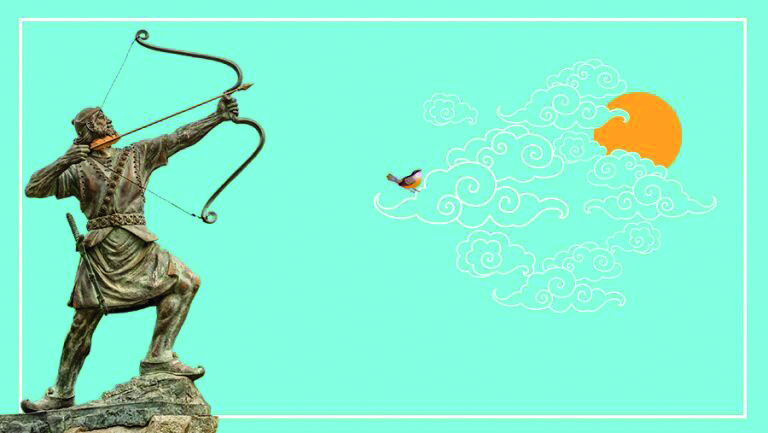 Parsis in India are currently celebrating the month of Tir and on Monday 25th November, 2024, Roj Tir will coincides with Mah Tir as per the Shahenshahi calendar, marking the Parab or festival of Tirgan, one of the three most widely celebrated seasonal festivals of ancient Iran. Tirgan is an ancient Iranian seasonal festival, alongside Navruz (spring), Yalda (winter) and Mehergan (autumn). Unfortunately, with both the Shahenshahi and Kadmi calendars completely out of sync with the Fasal or seasons, Tirgan (which is essentially a summer festival) is currently observed during autumn.
Parsis in India are currently celebrating the month of Tir and on Monday 25th November, 2024, Roj Tir will coincides with Mah Tir as per the Shahenshahi calendar, marking the Parab or festival of Tirgan, one of the three most widely celebrated seasonal festivals of ancient Iran. Tirgan is an ancient Iranian seasonal festival, alongside Navruz (spring), Yalda (winter) and Mehergan (autumn). Unfortunately, with both the Shahenshahi and Kadmi calendars completely out of sync with the Fasal or seasons, Tirgan (which is essentially a summer festival) is currently observed during autumn.
While Navruz (Mah Fravardin, Roj Hormuzd) celebrates renewed life and the warmth of spring after the cold winter season and Mehergan (Mah Meher, Roj Meher) commemorates harvest during autumn, Tirgan (Mah Tir, Roj Tir) welcomes the heat of summer and life-giving rain.
In the Zoroastrian religious texts, Testar-Tir is venerated as radiant, glorious and invoked in order to bring rain, enhance harvest and keep the demon of draught at bay. Little wonder that it was originally meant to be a rain or monsoon festival and still celebrated according to the Fasal or seasonal calendar in the month of July. Ironically, Parsis in India (following Shahenshahi calendar) will observe this festival well after the south-west monsoon season in India is over.
Tirgan Celebrations
Tirgan in Iran is celebrated in the summer month of July in anticipation of a good harvest and keeping drought at bay. It is celebrated by dancing, splashing water, reciting poetry, and consuming various traditional foods. There’s also a custom of tying rainbow-colored bands on wrists, worn for ten days and then thrown into a stream, accompanied by a wish. Many Zoroastrians still follow this Tirgan ritual.
As per late Professor Dr. Mary Boyce (‘Persian Stronghold of Zoroastrianism’), these colourful bands were worn as good-luck charms. The Rivayat however record that priests would write a Nirang (short prayer) which community members wore on their wrist or arm on Roj Tir of Mah Tir and removed it after ten days on Roj Govad and cast it into running brooks and streams, symbolically away casting all calamities (particularly draught and hunger).
The night before the thirteenth day of Tir (i.e., Roj Tir of Mah Tir), people gather at the house of the oldest family member and the host cooks a lavish meal comprising meat, rice and thirteen nutritive ingredients, like spinach, plums, raisins, beans and lentils. People celebrate with fruits and wheat commemorating the blessings endowed by the rain.
Traditional foods for Tirgan include Shol-e-zard (a sweet, saffron-infused rice pudding flavoured with flavoured with rosewater, cinnamon and cardamom, garnished with pistachios, almonds and rose petals) and Ash Reshteh (a thick soup made with beans, herbs, lentils, spinach, Iranian noodles and kashk – a preserve made of wheat or barley mixed with sour yoghurt.
 Heralding Rain
Heralding Rain
Tir, or Testar (Avestan Tishtrya), is the divinity presiding over the Star Sirius, viewed by most ancient civilizations as the earth’s second or spiritual sun. In Zoroastrian religious texts, Testar-Tir is venerated as radiant, glorious and invoked in order to bring rain, enhance harvest and keep the demon of draught at bay. According to the Fasal or seasonal calendar, Tirgan is celebrated in July and interestingly, ancient Egyptians also observed that in July, with the heliacal rising of the Star Sirius (Heliacal rising means the first night that a star is seen in the eastern horizon, just before dawn) the Nile generally started to flood and bring fertility to the land. Thus, the flood and the rising of Sirius also marked the ancient Egyptian New Year. The ancient Greeks also observed that the appearance of Sirius or the Dog Star heralded the hot and humid summer season causing plants to wilt and men to tire. The season following the star’s appearance came to be known as the ‘Dog Days of summer’, an expression still in use.
The Persian Rivayat (essentially correspondence between the Zoroastrian Priests of Navsari in India and the Zoroastrian priests of Yazd in Iran) speaks of a great draught in Iran as a result of the conflict between Iranians and Turanians. Shah Faridoon had segregated Iran and Turan under a covenant. However, the Turanians under Afrasiab breached the covenant. According to legend, when Afrasiab and the Turanians left Iran, it took all of them ten days to reach Turan. The tenth day was Roj Govad (dedicated to the good wind) and it rained heavily on that day, ending eight years of draught and ushering peace and prosperity for both, Iran and Turan.
Celestial Guardian
In Zoroastrianis, Ahura Mazda positioned four Guardians in the form of four fixed stars in the four sacred directions (east, west, south and north) to protect all good creations from Angre-Mainyu, the destructive spirit. These four Stars are mentioned in the Pahlavi Minog-i-Kherad and the Bundahishn (Zoroastrian book of Genesis), where Teshtar Tir (Sirius) guards the Eastern Sky, Satvas (Vega) guards the West, Vanant (Antares) guards the South and Haptrang (Pleiades) guards the North.
The Tir Yasht reveals that Ahura Mazda created Teshtar Tir (Sirius) as the chief of stars, as brilliant and worthy of worship, adoration and glorification, as Himself! Teshtar Tir is called ‘Rayomand’ and ‘Khorehmand’ which is the same way in which Ahura Mazda is addressed!
Legend of the Arrow (Tir)
Tirgan is associated with the legend of the arrow (Tir), which is briefly alluded to in the Tir Yasht: “We honor the bright, khwarrah (glory) endowed star Tishtrya who flies as swiftly to the Vouru-kasha Sea as the supernatural arrow which the archer Erexsha, the best archer of the Iranians, shot from Mount Airyo-xshutha to Mount Xwanwant. For Ahura Mazda gave him assistance; so, did the waters …”
The legend of Erexsha (modern Eruchsha) or Pahlavi Arish Shivatir i.e., Arish of the swift arrow is also referred to in other texts like Firdausi’s Shahnameh (Book of Kings) and Mirkond’s History of the Early Kings of Persia. As per later texts, Erekhsha or ‘Arish of the Swift Arrow’ was the best archer in the Iranian army. When Shah Minochihr and Afrasyab of pre-historic Iran decided to make peace, and fix the boundaries between Iran and Turan, it was agreed that Arish would ascend Mount Damavand in Northern Iran, and fire an arrow eastward, from its peak, and the place in where the arrow landed would form the boundary between the two kingdoms. Arish thereupon ascended the mountain, and discharged an arrow, the flight of which continued from the dawn of day until noon, when it fell on the banks of the Jihun (the Oxus or Amu Darya in Central Asia, in modern times, the border around Tajikistan and Afghanistan). The day was Tir Roj of Tir Mah. Thus, the festival of Tirgan also celebrates the spirit of peace and freedom.
Invoking Tir
In the Tir Yasht, we invoke Tishtrya as ‘Provider of rain, helpful and health giving.’ In fact, Tishtrya Yazata affirms in the same litany, “If men would worship me with the Yasna in which my own name is invoked, then I would render the world prosperous and fertile by showering rain.”
The Tir Yasht also records the victory of Tishtrya over Apaosha, the demon of drought and ensuring happiness not just for people but all vegetation and animals.
In the Khurshed and Meher Nyaish we pray ‘tishtrim dravo chashmanem yazamaide’, which means ‘we venerate Tishtrya (Tir Yazad), of good eyesight (chashman) or giver of good eyesight.’ This is one of the reasons why reciting the Tir Yasht is recommended for those with weak eyesight or ophthalmic problems.
- Gratitude In Full Bloom This Dae Mahino! - 17 May2025
- Lessons Of History – Darius III And The Fall Of The Achaemenid Empire - 3 May2025
- The Sacred Ash Of Reinforcement, Resilience And Renewal - 26 April2025
